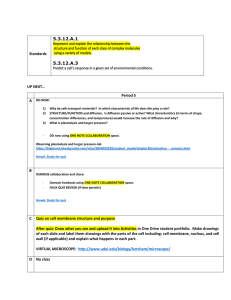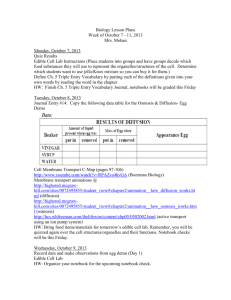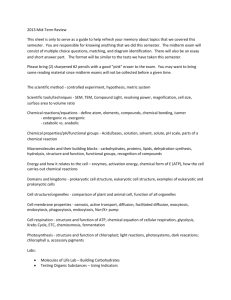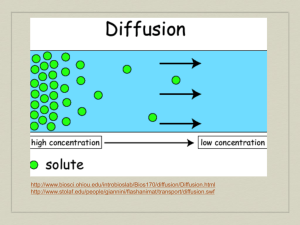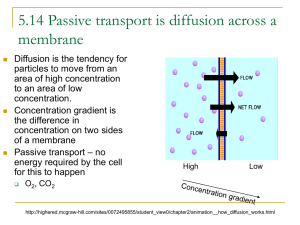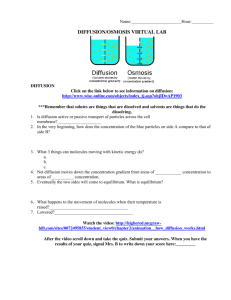Virtual Lab: Passive and Active Transport
advertisement
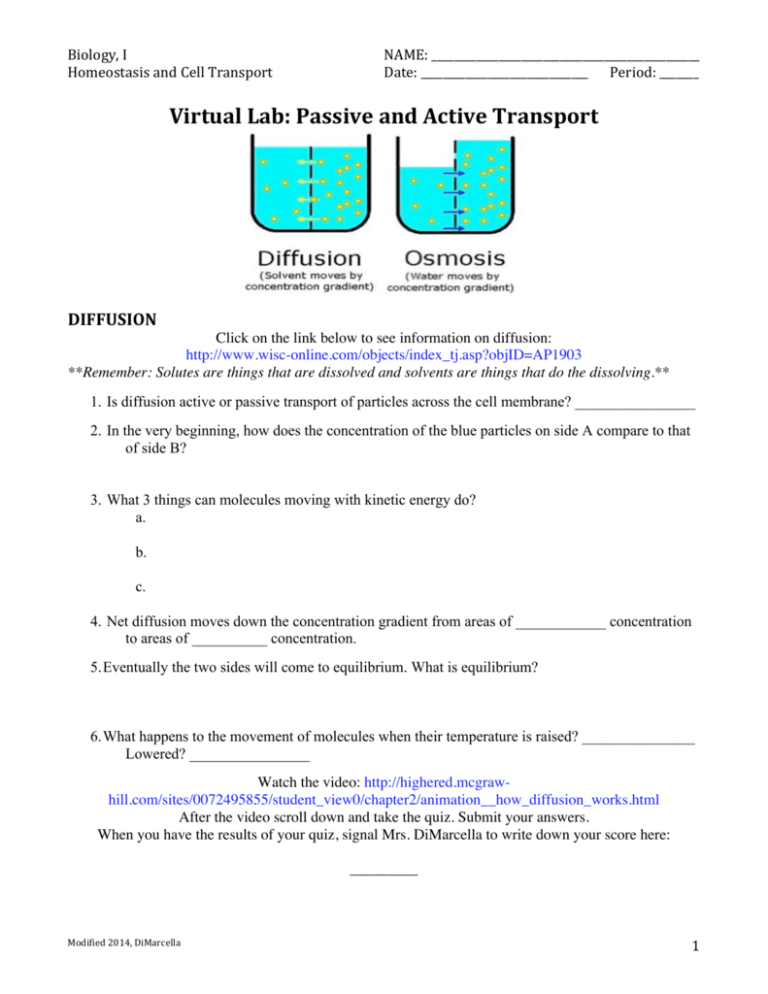
Biology, I Homeostasis and Cell Transport NAME: ________________________________________________ Date: ______________________________ Period: _______ Virtual Lab: Passive and Active Transport DIFFUSION Click on the link below to see information on diffusion: http://www.wisc-online.com/objects/index_tj.asp?objID=AP1903 **Remember: Solutes are things that are dissolved and solvents are things that do the dissolving.** 1. Is diffusion active or passive transport of particles across the cell membrane? ________________ 2. In the very beginning, how does the concentration of the blue particles on side A compare to that of side B? 3. What 3 things can molecules moving with kinetic energy do? a. b. c. 4. Net diffusion moves down the concentration gradient from areas of ____________ concentration to areas of __________ concentration. 5. Eventually the two sides will come to equilibrium. What is equilibrium? 6. What happens to the movement of molecules when their temperature is raised? _______________ Lowered? ________________ Watch the video: http://highered.mcgrawhill.com/sites/0072495855/student_view0/chapter2/animation__how_diffusion_works.html After the video scroll down and take the quiz. Submit your answers. When you have the results of your quiz, signal Mrs. DiMarcella to write down your score here: _________ Modified 2014, DiMarcella 1 Biology, I Homeostasis and Cell Transport NAME: ________________________________________________ Date: ______________________________ Period: _______ OSMOSIS Click on the link below to see information on osmosis: http://www.wisconline.com/objects/index_tj.asp?objID=AP11003 7. What is osmosis? 8. What does the dashed line in the beaker separating the two sides represent? __________________ 9. Why are they assuming the large molecules will stay on their own side of the membrane? 10. Because molecules will move from one side to another to come to an equilibrium, or balance of concentration, the _________________________moves from side B to side A, so the water level on side A goes ______________. 11. In living things, cells must be in a __________________ solution where water leaves and enters the cell at _______________________________. 12. What happens to a cell in a concentrated, hypertonic environment? Click on the “View Movie” icon to find out. 13. What happens to a cell in a concentrated, hypotonic environment? Click on the “View Movie” icon to find out. Watch the video: http://highered.mcgrawhill.com/sites/0072495855/student_view0/chapter2/animation__how_osmosis_works.html After the video scroll down and take the quiz. Submit your answers. When you have the results of your quiz, signal Mrs. DiMarcella to write down your score here: _________ THE ALIEN EGG EXPERIMENT Watch the video presentation: http://tinyurl.com/lgffq7m and complete the next series of questions: 1. What effect did the vinegar have on the eggs? 2. Why did the mass of the egg increase after soaking in the vinegar solution? 3. Name the process that is occurring. Modified 2014, DiMarcella 2 Biology, I Homeostasis and Cell Transport NAME: ________________________________________________ Date: ______________________________ Period: _______ 4. What material seems to have moved through the membrane of the egg after it soaked in the corn syrup? In what direction did the material move? 5. At what point was the egg in a hypertonic solution? Explain what happened in this process. 6. At what point was the egg in a hypotonic solution? Explain what happened in this process. TRANSPORT PROCESSES REQUIRING ATP Click on the link below to see information on transport processes requiring ATP: https://www.wisconline.com/learn/natural-science/life-science/ap11203/transport-processes-requiring-atp 14. What does ATP energy stand for? 15. With ATP energy, the carrier transports the molecule from an area _________________ concentration to an area of ___________________ concentration. 16. ______% of the cell’s ATP may be used in this type of transport across the cell membrane. 17. What is endocytosis? 18. In the top movie, ________________________ process is being simulated. Explain what is occurring. 19. In the bottom movie ________________________ process is being simulated. Explain what is occurring. 20. Explain how the exocytosis works. Watch the video: http://highered.mheducation.com/sites/9834092339/student_view0/chapter38/how_the_sodium_potassiu m_pump_works.html After the video scroll down and take the quiz. Submit your answers. When you have the results of your quiz, signal Mrs. DiMarcella to write down your score here: _________ Modified 2014, DiMarcella 3
